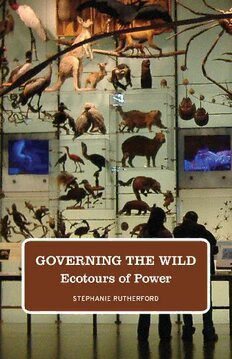
Governing the Wild: Ecotours of Power PDF
Preview Governing the Wild: Ecotours of Power
GOVERNING THE WILD This page intentionally left blank Governing the Wild • • • • Ecotours of Power Stephanie Rutherford University of Minnesota Press Minneapolis London Copyright 2011by the Regents of the University of Minnesota All rights reserved. No part of this publication may be reproduced, stored in a retrieval system, or transmitted, in any form or by any means, electronic, mechanical, photocopying, recording, or otherwise, without the prior written permission of the publisher. Published by the University of Minnesota Press 111Third Avenue South, Suite 290 Minneapolis, MN 55401-2520 http://www.upress.umn.edu Library of Congress Cataloging-in-Publication Data Rutherford, Stephanie. Governing the wild : ecotours of power / Stephanie Rutherford. p. cm. Includes bibliographical references and index. ISBN 978-0-8166-7440-4(hc : alk. paper) ISBN 978-0-8166-7447-3(pb : alk. paper) 1. Ecotourism. I. Title. G156.5.E26R88 2011 910.4—dc23 2011028086 Printed in the United States of America on acid-free paper The University of Minnesota is an equal-opportunity educator and employer. 18 17 16 15 14 13 12 11 10 9 8 7 6 5 4 3 2 1 to Paul Rutherford, my father, for his trenchant insight and thoughtful guidance This page intentionally left blank Contents Introduction: Governing Nature ix 1. Ordering Nature at the American Museum of Natural History 1 2. Disney’s Animal Kingdom: The Wild That Never Was 43 3. Wolves, Bison, and Bears, Oh My! Defining Nature at Yellowstone and Grand Teton National Parks 89 4. Science and Storytelling: Al Gore and the Climate Debate 139 Conclusion: Being Otherwise 183 Acknowledgments 205 Notes 207 Bibliography 213 Index 231 This page intentionally left blank • INTRODUCTION • Governing Nature Many Stories, One Discourse In the Hall of Biodiversity at the American Museum of Natural History in New York is a glass case embedded in the floor of the exhibit called “The Crisis Zone.” Housed within this case is a number of extinct or endan- gered animal specimens, the most notable among them being a giant Ben- gal tiger. Its eyes are alert, round, steady; it regards the viewer almost in surprise at the encounter. Its gaze draws the viewer in, inviting a connec- tion—a mutual recognition of the other and understanding that its wild cousins are under threat. This is charismatic megafauna at its best, and its presence countenances reflection on how things could have gone so badly awry. Its beauty provokes a question: what can we do to stem the tide of environmental destruction so that animals such as this can be saved? But it is also a dead tiger; no breath will illuminate its luxuriant fur, no life can be detected in its static gaze. And so, while it appears that this tiger offers the museum visitor something, it is, in fact, a one-sided story. It has been killed, stuffed, and displayed by museum curators, first to show peo- ple nature from a distant land, and now as a cautionary tale of the excesses of modernity. In either iteration, it did not choose its fate. Rather, it is a sacrificial specimen, its life having been taken in the pursuit of science; it has died so it can never die. And its presence acts as an allegory in a mod- ern bestiary, a morality tale about the impending death of nature. This ossuary of biotic life instructs the visitor about what will happen if we do not act for nature. The American Museum of Natural History’s Hall of Biodiversity is but one of the case studies that animates this book. The others are Disney’s Animal Kingdom, an ecotour to Yellowstone and Grand Teton National Parks, and Al Gore and his film An Inconvenient Truth.Given the diversity of the cases represented, it would seem that scene described above would be an isolated one, particular only to museums and their visual logic of dis- play and representation. However, the narrative of the tiger does not stand • ix •
